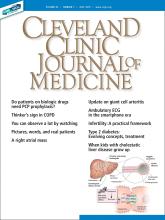Article Figures & Data
Tables
- TABLE 1
Autistic disorder, Asperger syndrome, and autism spectrum disorder: Past and present terminology and definitions
Autistic disordera Asperger syndromea Autism spectrum disorderb Qualitative impairment in social interaction
Qualitative impairments in communicationQualitative impairment in social interaction Persistent deficits in social communication and social interaction across multiple contexts (can specify severity as level 1, level 2, or level 3, with level 3 requiring the most support) Restricted, repetitive, and stereo-typed patterns of behavior, interests, and activities Restricted, repetitive, and stereo-typed patterns of behavior, interests, and activities Restricted, repetitive patterns of behavior, interests, or activities Delays or abnormal functioning in at least 1 of the following areas, with onset before age 3:
Social interaction
Language as used in social communication
Symbolic or imaginative playClinically significant impairment in social, occupational, or other important areas of functioning
No clinically significant general delay in language (eg, single words used by age 2, communicative phrases used by age 3)
No clinically significant delay in cognitive development or in the development of age-appropriate self-help skills, adaptive behavior (other than social interaction), and curiosity about the environment in childhoodSymptoms present in the early developmental period (but may not become fully manifest until social demands exceed limited capacities, or may be masked by learned strategies in later life)
Symptoms cause clinically significant impairment in social, occupational, or other important areas of current functioning
Providers can now specify au- tism spectrum disorder with or without intellectual impairment and language impairmentDisturbance is not better accounted for by Rett disorder or childhood disintegrative disorder Criteria not met for another specific pervasive developmental disorder or schizophrenia Disturbances not better explained by intellectual disability (intellectual developmental disorder) or global developmental delay Provide "wrap-around" healthcare transitions when new patients enter the practice, addressing the need for services, insurance coverage, and the frequency and nature of anticipated future appointments. Appreciate the heterogeneous nature of autism spectrum conditions and varying needs and achievements of individual patients and families. Aim to provide a medical home for the patient and family. Gain familiarity with the local and regional specialists, generalists, and social workers who provide care for this population to facilitate referrals for behavioral management strategies and comorbidities if needed. Gain basic familiarity with local residential and job-training programs. Assess the level of patient impairment due to autism spectrum disorder and any psychiatric and medical comorbidities. Treat to reduce impairment rather than eliminate symptoms. When initiating medications, use a low dose and a slow titration schedule to minimize adverse effects. Wean or eliminate medications when possible. Address sexual health needs on an individual basis, minimizing assumptions about sexual preference, gender identity, and sexual history. Aim to provide preventive care in accordance with guidelines. Recognize that high levels of caregiver stress and isolation are not infrequent, and encourage development of a social support network for the entire family.






